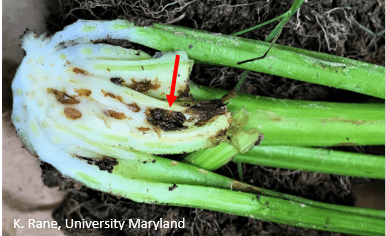Jerry Brust, IPM Vegetable Specialist, University of Maryland; jbrust@umd.edu
Last year we saw some samples of celery with celery leaf curl, or celery anthracnose. We are seeing the disease again, but in different fields than before, which is a bit worrisome. I honestly did not know there was this much celery grown in Maryland. First observed in the U.S. in 2010, this disease is becoming increasingly important in our celery crops. The most noticeable symptom in the field is unusual twisting or downward curling of celery leaves and petioles (stalks) (fig. 1). The curling of leaves looks like something you’d see from a growth regulating chemical. Infected plants may be somewhat stunted, but the foliage usually remains a green to pale green color (unlike the chlorotic (yellow) leaves caused by aster yellows). Brown elongated lesions develop on the stalks (fig. 2) that can enlarge over time. Secondary soft rot bacteria often invade infected plants, resulting in blackened, rotted crown tissue (fig. 3).
The fungus causing this disease was originally identified as Colletotrichum acutatum, but recent taxonomic research has divided the C. acutatum group into several species, and both C. fioriniae and C. nymphaeae in that group have been found to cause celery leaf curl. Both fungal species can cause disease on other crops, such as strawberry, but it’s not known if there are differences between isolates from different crops.
These fungi can overwinter on infected plant debris or weed hosts. There are also reports that the fungi may be seed-borne. Warm (75-86o F), wet conditions favor outbreaks of this disease but even temperatures as cool as 60o F will allow it to spread in a field as spores can be splash-dispersed from plant to plant. This disease is usually most active when it has been very hot and humid with occasional thunderstorms (i.e., our usual summer weather pattern). Anything that increases the leaf wetness period will make the disease situation worse.
Management starts by using good sanitation techniques in transplant production (clean trays, no plant debris, scouting for symptoms). Hot water treatment of celery seed (50o C for 30 minutes) can eliminate the pathogen. Inspect plants for symptoms prior to planting and continue to inspect crops in the field (during dry weather) and rogue out any plants with symptoms. Keep weeds under control to encourage drying of foliage after rain events. Avoid overhead irrigation and use mulches to keep field soil from splashing into celery crowns. A 3-4 year crop rotation out of celery helps reduce the inoculum present in the field. Although a few celery varieties have shown some tolerance to the disease, no variety is resistant at this time and all can show symptoms.
Fungicides used to manage other celery foliar diseases are effective in managing anthracnose as well. Strobilurin fungicides in FRAC code 11 have been found to be particularly effective at slowing the spread of the disease and maintaining yields and quality. Fungicides should always be rotated to include different modes of action to avoid resistance development.
- Fig. 1 Celery stalk infected with Anthracnose (right) vs stalk not infected (left)
- Fig. 2 Brown lesions on stalk with anthracnose
- Fig. 3 Secondary soft rot bacteria in crown of plant infected with anthracnose



